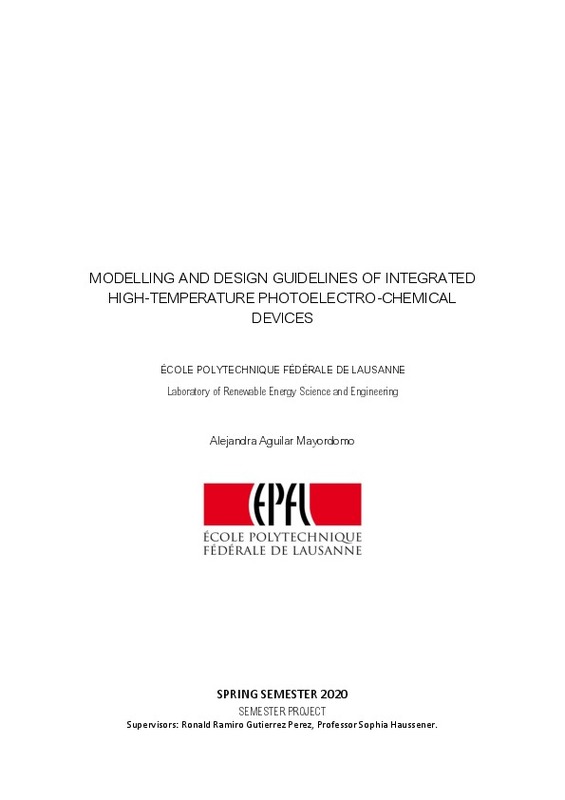JavaScript is disabled for your browser. Some features of this site may not work without it.
Buscar en RiuNet
Listar
Mi cuenta
Estadísticas
Ayuda RiuNet
Admin. UPV
Modelling and design guidelines of integrated high-temperature photoelectro-chemical devices
Mostrar el registro sencillo del ítem
Ficheros en el ítem
| dc.contributor.advisor | Sanchís Arnal, Ricardo
|
es_ES |
| dc.contributor.advisor | Gutierrez Perez, Ronald Ramiro
|
es_ES |
| dc.contributor.author | Aguilar Mayordomo, Alejandra
|
es_ES |
| dc.date.accessioned | 2021-02-05T07:40:52Z | |
| dc.date.available | 2021-02-05T07:40:52Z | |
| dc.date.created | 2020-09-11 | |
| dc.date.issued | 2021-02-05 | es_ES |
| dc.identifier.uri | http://hdl.handle.net/10251/160774 | |
| dc.description.abstract | [EN] In the present study, hydrogen and syngas fuels are delivered from water electrolysis and coelectrolysis of water and carbon dioxide, respectively, though the use of an integrated hightemperature photoelectrochemical device, composed of a high temperature solar cell (HTSC) coupled with a solid oxide electrolyser (SOE). Clean, renewable and available solar energy is used as the power source of this device. A numerical multiphysics model is developed, including a one-dimensional model designed to represent the high temperature photoabsorber assembly, and a two-dimensional model embodying the solid oxide electrolyser. The performance of this integrated device is assessed according to certain parameters, including the molar flow of fuel produced at the outlet of the device and the solar-to-fuel efficiency. The productivity of the device is analysed for both fuel production simulations under a variety of different scenarios, where parameters affecting the structure’s design, the material properties and the operating and boundary conditions are varied. The resulting energetic and production performances under each case scenario are measured and appraised, in order to get a broader insight in the effect of these variables in the performance of the fuel-producing device and provide general device design guidelines. The acquired results show the difference in importance of some specifications over others in the performance of the device. The parametric study for the hydrogen production reveals the number of photoabsorbers as the parameter which most significantly affects the performance of the device. In order to maximise the performance of the HTSC-SOE integrated device, addressing this parameter, a simulation is carried out which allowed to determine the optimum combination of parameters that the device should possess in order to obtain the maximum solar-to-fuel efficiency possible and deliver the highest amount of hydrogen molar flow rate. On the other hand, the parametric study of the syngas fuel production though the co-electrolysis of H2O and CO displays that the H2/CO ratio is the most decisive variable which influences the amount of hydrogen and carbon dioxide generated. The reduction of the source of H2 formation, by diminishing the inlet molar fraction of water at the cathode chamber, is proved to affect the H2/CO ratio of the device to a bigger extent than increasing the temperature of the electrolyser components. In either of the two simulations, high efficiencies can be accomplished by reducing the required electric power of the electrolyser, which is achieved by increasing its operating temperature. | es_ES |
| dc.description.abstract | [ES] En este proyecto se diseña un dispositivo integrado para la producción de hidrógeno en el que la electrólisis de agua para producirlo se alimenta de la corriente producida por un panel solar (que usa energía solar). La eficiencia se estudia variando ciertos parámetros de diseño, como puede ser la velocidad de entrada de las especies en las cámaras del ánodo y cátodo, a través de un estudio paramétrico, con el fin de poder definir parámetros generales de diseño. Los programas utilizados son: MATLAB (para modelar el panel solar) y COMSOL (para modelar el electrolizador). | es_ES |
| dc.format.extent | 84 | es_ES |
| dc.language | Inglés | es_ES |
| dc.publisher | Universitat Politècnica de València | es_ES |
| dc.rights | Reconocimiento - No comercial - Sin obra derivada (by-nc-nd) | es_ES |
| dc.subject | Electrólisis | es_ES |
| dc.subject | Dispositivo integrado | es_ES |
| dc.subject | Energía solar | es_ES |
| dc.subject | Hidrógeno | es_ES |
| dc.subject | Panel solar | es_ES |
| dc.subject | Eficiencia | es_ES |
| dc.subject | Análisis paramétrico | es_ES |
| dc.subject | Electrolysis | es_ES |
| dc.subject | Integrated device | es_ES |
| dc.subject | Solar energy | es_ES |
| dc.subject | Hydrogen | es_ES |
| dc.subject | Solar panel | es_ES |
| dc.subject | Efficiency | es_ES |
| dc.subject | Parametric analysis | es_ES |
| dc.subject.classification | INGENIERIA NUCLEAR | es_ES |
| dc.subject.other | Grado en Ingeniería en Tecnologías Industriales-Grau en Enginyeria en Tecnologies Industrials | es_ES |
| dc.title | Modelling and design guidelines of integrated high-temperature photoelectro-chemical devices | es_ES |
| dc.type | Proyecto/Trabajo fin de carrera/grado | es_ES |
| dc.rights.accessRights | Abierto | es_ES |
| dc.contributor.affiliation | Universitat Politècnica de València. Departamento de Ingeniería Química y Nuclear - Departament d'Enginyeria Química i Nuclear | es_ES |
| dc.contributor.affiliation | Universitat Politècnica de València. Escuela Técnica Superior de Ingenieros Industriales - Escola Tècnica Superior d'Enginyers Industrials | es_ES |
| dc.description.bibliographicCitation | Aguilar Mayordomo, A. (2020). Modelling and design guidelines of integrated high-temperature photoelectro-chemical devices. http://hdl.handle.net/10251/160774 | es_ES |
| dc.description.accrualMethod | TFGM | es_ES |
| dc.relation.pasarela | TFGM\131021 | es_ES |
Este ítem aparece en la(s) siguiente(s) colección(ones)
-
ETSII - Trabajos académicos [10404]
Escuela Técnica Superior de Ingenieros Industriales






